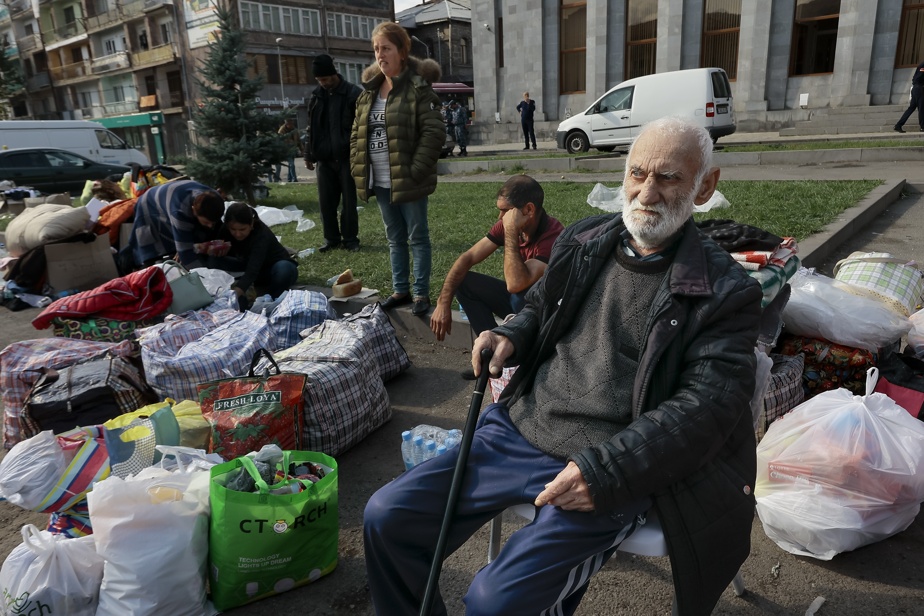(Kornidzor) The separatist republic of Nagorno-Karabakh was almost entirely deserted by its inhabitants on Saturday after the lightning victory in Baku, with more than 100,000 refugees having fled to Armenia for fear of reprisals from Azerbaijan.
While their reception is being organized with difficulty and the UN is expected in the enclave this weekend, the opponents of Prime Minister Nikol Pashinian, accused of passivity and abandoned by Moscow, plan to give voice again in the Street.
According to Prime Minister’s spokesperson Nazeli Baghdassarian, “100,417 people” have now “entered Armenia” since the capitulation of September 20, or more than 80% of the 120,000 Armenians who officially lived in the enclave before the offensive Azerbaijani.

PHOTO VASILY KRESTYANINOV, ASSOCIATED PRESS
An Armenian family having left Nagorno-Karabakh arrives with their belongings in Goris on September 30.
“There are still a few hundred civil servants, emergency workers and people with special needs, who are also preparing to leave,” former Nagorno-Karabakh rights ombudsman Artak Beglarian wrote on are “not official”.
At the Kornidzor crossing point, an AFP journalist saw only a few ambulances arrive, with border guards indicating that they were still expecting the last buses carrying civilians.
In the nearest town of Goris, hundreds of refugees wait to be offered accommodation in the central square, amid their luggage.
UN mission
The UN announced that it had received the green light to send a mission to the territory this weekend in order to mainly assess humanitarian needs, while the organization has not had access to this region “since about 30 years.
France deplored its “limited” and late authorization granted by Azerbaijan, arriving after the flight of the population “under the complicit gaze of Russia”.
The Quai d’Orsay stressed on Saturday that Paris was reaffirming “its commitment to supporting the sovereignty and territorial integrity of Armenia where these populations have found refuge.”
In total, nearly 600 deaths have been reported in the wake of Baku’s victorious military offensive. The fighting itself killed around 200 soldiers on each side.
The enclave decreed on Thursday the spectacular dissolution of “all government institutions […] at 1er January 2024”, a historic announcement marking the end of the existence of the self-proclaimed “Nagorno-Karabakh Republic” more than three decades ago.
Its panicked residents left their homes for fear of reprisals by burning their personal belongings before joining the column of refugees of all ages.

PHOTO NANNA HEITMANN, THE NEW YORK TIMES
Cars arrive at the crossing point in the village of Kornidzor, Armenia, after leaving Nagorno-Karabakh on September 25.
Fear of arrests
This predominantly Christian region, which seceded from predominantly Muslim Azerbaijan upon the disintegration of the USSR, opposed Baku with the support of Armenia for more than three decades, notably during two wars between 1988 and 1994 and in the fall of 2020.
It was massively militarized and all the men there had combat experience.
This fear is fueled, according to Yerevan, by a series of “illegal arrests”, although the Azerbaijani authorities have committed to allowing rebels who surrender their weapons to leave.
Several officials from the enclave have been placed in detention, accused of “terrorism” and other crimes, like former foreign affairs official David Babaian, arrested on Friday.
Between Kornidzor and Goris, near a gas station where he loaded his car with gas bottles on Friday, former soldier Garri Harioumian, 38, says he deleted photos of his “dead friends” on the front from his phone. .
In their escape on the only mountainous road linking the territory to Armenia, at least 170 people also died in the explosion of a fuel depot on Monday. The accident also left 349 people injured, most of them suffering from serious burns.
Demonstration in Armenia
Samvel Hambardsioumian, taken into care in Goris, is one of them: his face is partially burned and his two hands are surrounded by thick bandages.
“There were nine people in front of me in line. If they hadn’t been there, I would have been burned to death,” the 61-year-old man told AFP.
The chaotic flow has revived accusations of “ethnic cleansing”, with Yerevan launching a new appeal to the International Court of Justice (ICJ), demanding urgent measures to protect the enclave’s residents.
And opponents of Prime Minister Nikol Pashinian, held responsible for the debacle, planned to organize a rally on Saturday at 9 a.m. (Eastern time) after having muted their criticism in recent days to welcome the refugees.
Yerevan blames Russia, a traditional ally supposed to guarantee full respect of the ceasefire since 2020 and which did not intervene.
